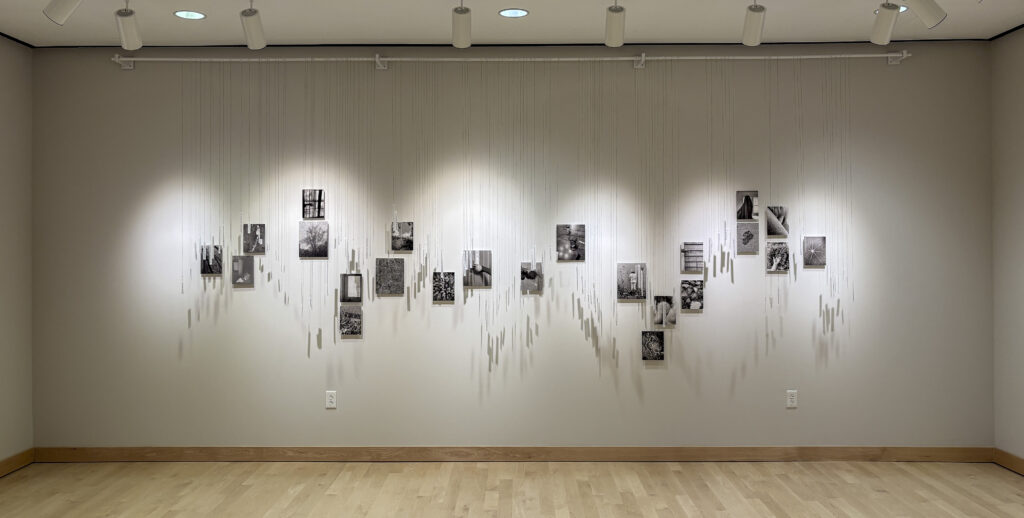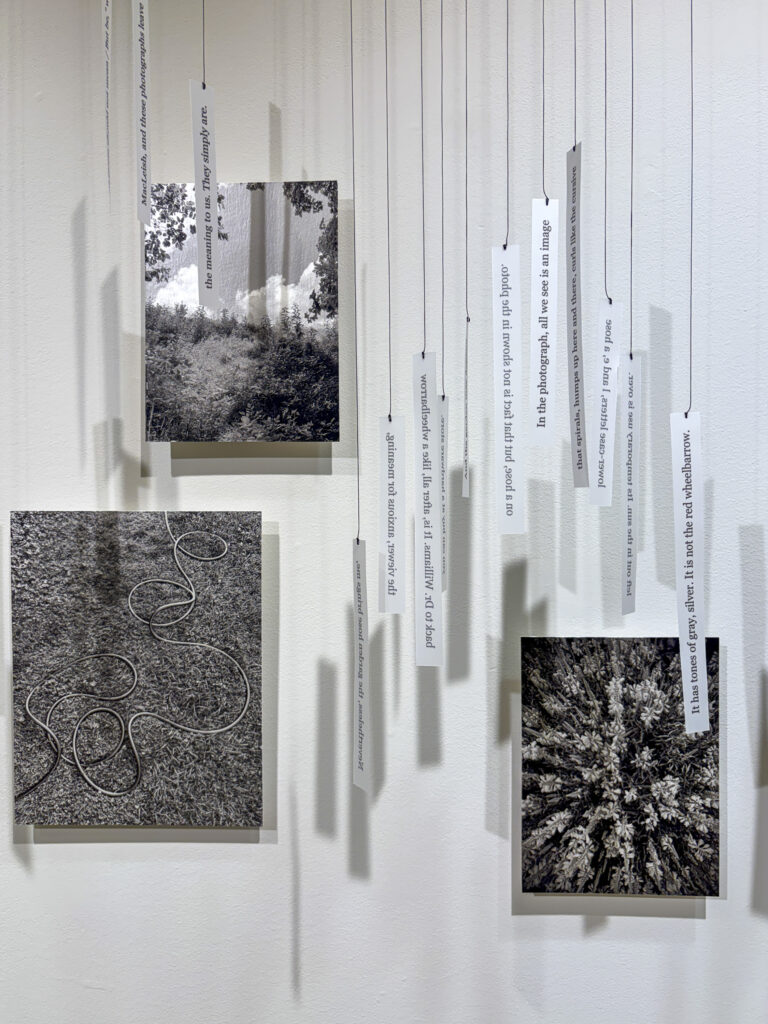The Day Is Made of Light


The Day is Made of Light is a collaborative project between the poet LaWanda Walters and myself. Our work together began with a connection about light and shadow. As a photographer, light is essential to my craft and as a poet the attention to illumination in both literal and metaphorical ways runs throughout LaWanda’s work. The Day Is Made of Light comes from a mutual respect and understanding of all the ways the light allows us to notice. It is not something we can take the credit for; it is a gift we can receive if we are paying attention.
The Day Is Made of Light is also about transformation and the way we understand, and build meaning, in the things we see. The photographs and text both hang, suspended from the wall. The light passes through the paper and casts shadows where the threads appear. I think of it, when it moves, as the light coming through the leaves of a tree, flickering and dancing. The suspended text invites the viewer to touch, to push aside to reveal the photograph, or to collect in the palm of the hand to consider the words. Perhaps it will all get a little mixed up, and that’s okay, too. “The light shows us what we get to notice”, and this work may draw awareness to one’s sense of looking, of exploring, and seeing the world around us.
The Day Is Made of Light – Poem by LaWanda Walters
The day is made of light—
a photographic, silver-plated proof
of mornings, afternoons, the view
through a screen porch, cropped
in places that throw us off balance.
This monochrome view, like the black
and white keys of a piano’s chromatic scale,
shows more than color. There is no red wheelbarrow
here—perhaps a green water hose that appears
in a tone somewhere between black and white—
but here is William Carlos Williams’ poem
of how images work:
so much depends
upon
a red wheel
barrow
glazed with rain
water
beside the white
chickens
This shows how line breaks matter,
how the white margins of a page will frame
“glazed with rain”
and “barrow”
as if the words were photographs.
And so the line of the garden hose, unbroken,
has its own song as it curves and writhes
upon the grass—coiled although it is not a snake.
So much depends
on what we make of it.
The hose coils like a snake because
we have seen snakes coil in the movies—
or closer—but in this case the hose’s loose coils
stay curved because they’ve been shaped
by water, under pressure in the tube, making it seem
to writhe and coil. Water pressure makes
an unvenomous garden hose move
like Dickinson’s “narrow Fellow in the Grass.”
Doesn’t the narrow fellow give you a thrill
between the shoulder blades?
“A poem should not mean / But be,” wrote Archibald
MacLeish, and these photographs leave
the meaning to us. They simply are.
Nevertheless, the garden hose brings me,
the viewer, anxious for meaning,
back to Dr. Williams. It is, after all, like a wheelbarrow
you can buy at a hardware store.
And the garden may depend
on a hose, but that fact is not shown in the photo.
In the photograph, all we see is an image
that spirals, humps up here and there, curls like the cursive
lower-case letters, l and e, a hose
left out in the sun. Its temporary use is over.
It has tones of gray, silver. It is not the red wheelbarrow.
In the photographer’s work, nothing can depend.
The photos lie open, plainly, with no titles.
The photos are cropped in ways
like our own cropped days and memories.
If nothing can depend, all we can do is record
what we can of our days in the light—
how one photograph shows sunlight’s aim
through a window as a kind of wainscoting
across the opposite wall that is bubbly and frothy.
A child’s hand rests at one end
of the temporary decoration
of light and curve. You’d think her hand
would cover that rococo sunbeam,
but the light fastens itself
to the back of her hand, which is curved, plump,
eloquent, presenting the creamy, stirred-up decoration,
reminding me of how
we look in water—
or the child’s shadow on a beach, her hair
wild as a mermaid’s as we see her in silhouette,
dark against the bright sand, those grains
fairy mirrors showing light bounce
as children jump and play
in the surf.
There are objects on a wooden kitchen table—
my mind tries to see them as a still-life
in black and white, a series of objects left
on a table: a salt shaker, a glass
half-full, half-empty of water,
a used band-aid (clean enough, just unraveled,
left by a child after getting a vaccination, perhaps,
to uncurl on the table). There is the muted reflection
of five lights—five as in hand, as in leaf, as in star—
as in the hanging lamp which might be above the table.
It is not a still life—it is life, evident on the table,
and half-cropped out of the photo,
the top part of a hairbrush.
There are artists who are clearly
also parents—mothers especially, like Mary
Cassatt and Berthe Morisot. I find that nurturing
in these photos—the kitchen table with its detritus,
and the fact that the photographer’s main model
is her young daughter, whom we can see
from the back, facing
a wall (stone or terra cotta),
her blonde, straight hair rhyming with the dried
stalks of wildflowers, some of which are as tall
as she is. Patterns connect
these works as much as anything—
a dead branch on the ground, still in the shape
of its former reaching
toward the sun, a young girl’s hand—
bent to hold the top of a dead pussy willow stem,
placed against the grid
of a window, holding a dandelion
puff—gently, her two hands a little bowl.
There is another photo of the child
behind the scrim
of a window screen,
another of her holding a butterfly.
There is light on stones, on a deserted
wasp’s nest, in the center of a leaf
with its star of a pattern.
I am asked to notice what is around.
The aim, I think, is ecological. It is also
a mother’s art—the protection of life in moments,
the catching of the fleeting
haphazard moments without technical
extremes—just a camera
aimed at the ground,
at the child, at the light within a leaf.